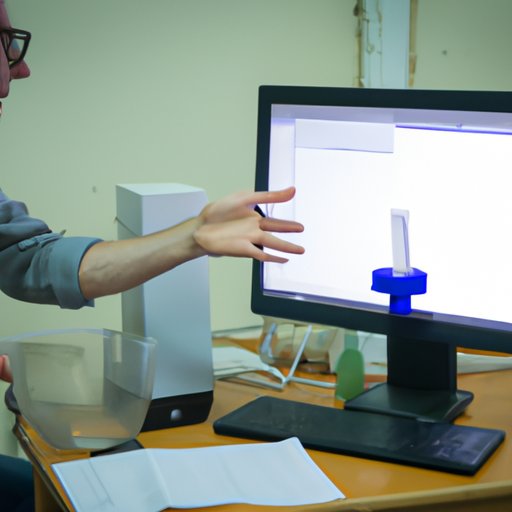
I. Introduction
Uncertainty is an integral part of many scientific experiments and data analysis processes. It is the measure of the doubt or randomness associated with a measurement or result. Calculating uncertainty is important because it provides a realistic estimation of the uncertainty range associated with a given value and helps researchers to make accurate and reliable conclusions. This article aims to provide a beginner’s guide to calculating uncertainty, detailing its significance and offering practical examples and step-by-step instructions.
II. Simplify the Complex: A Beginner’s Guide to Calculating Uncertainty
Uncertainty is a concept that can be difficult to understand. It is the result of errors and inaccuracies in the measurement, instrument, or sampling processes. Two common types of uncertainties are systematic uncertainties, which arise from flaws in the experimental or measurement setup, and random uncertainties, which arise from inherent variability in the measurement processes.
To calculate uncertainty, it is important to determine the source and magnitude of the errors involved. This information is then used to determine the probability of obtaining a result that deviates from the true value. The basic principle of uncertainty calculation involves taking repeated measurements and using statistical methods to determine the standard deviation of the measurements.
Practical applications of uncertainty calculation can be seen in a variety of fields, including engineering, finance, and healthcare. For example, in engineering, uncertainty calculation is used in the design of components and systems to minimize the risk of failure due to operating conditions and manufacturing variations. In finance, risk management and investment decisions are based on the uncertainty range associated with the market trends and individual investments. In healthcare, uncertainty calculation is used to measure the accuracy and reliability of diagnoses, treatments, and medical equipment.
III. Getting Real with Uncertainty: Step-by-Step Instructions for Accurate Calculations
Calculating uncertainty involves a step-by-step process that requires careful consideration of the sources and magnitude of the errors involved. The following guidelines and rules should be followed to ensure accurate calculations:
- Identify and describe the measurement or result that needs uncertainty calculation.
- Identify the sources of uncertainty and categorize them as systematic or random.
- Express the uncertainties as standard deviations.
- Combine the uncertainties to obtain the combined standard deviation.
- Use statistical methods to determine the probability distribution function.
- Calculate the uncertainty range using the probability distribution function.
Examples and exercises can aid in practicing the above steps for accurate calculations. The calculated uncertainty can be used in real-life problem solving scenarios such as measurement comparison and calibration, error propagation, and statistical analysis.
IV. The Importance of Understanding Uncertainty in Science: A Practical Guide to Calculation
Uncertainty is a critical factor in scientific experiments, as failing to calculate it can lead to flawed conclusions. The validity and reliability of scientific data depend on the accuracy of the uncertainty estimation. Real-life examples of flawed experiments due to failure in calculating uncertainty include the Mars Climate Orbiter and the Deepwater Horizon oil spill. Due to the absence of accurate uncertainty calculations, these experiments resulted in significant financial and environmental damage.
Uncertainty also plays a key role in scientific reporting and communication. The accuracy of scientific data can be compromised if the uncertainty range is not reported, leading to confusion or misuse of scientific findings.
V. Mastering the Art of Uncertainty: Tips and Techniques for Precise Calculations
Advanced techniques for calculating uncertainty include statistical and probabilistic methods. These methods involve a more sophisticated analysis of the data, and can offer more accurate and precise results. Strategies for minimizing uncertainty include experimental design and data analysis. Proper planning of experiments and careful analysis of data can reduce the sources and magnitude of uncertainties.
Software tools and resources are available to aid in the calculation of uncertainty. These tools can automate the process of uncertainty calculation and also provide additional guidance on best practices and error reduction strategies.
VI. Navigating the Unknown: A Comprehensive Guide to Calculating Uncertainty in Any Field
Uncertainty is a part of any field involving measurements and experimentation. Understanding the principles of uncertainty calculation can be useful in a variety of industries, not just science. For instance, in finance, the uncertainty associated with the market trends and individual investments determines investment decisions and risk management strategies. In healthcare, uncertainty associated with diagnosis and treatment plans determines the accuracy and reliability of patient care. The principles of uncertainty calculation can be adapted to various contexts and scenarios for precise and accurate results.
VII. Conclusion
In conclusion, calculating uncertainty is an important tool for accurately measuring and analyzing scientific data. Understanding and applying the principles of uncertainty calculation can lead to more reliable and accurate results, reducing the risk of flawed experiments and financial or environmental damage. By following the step-by-step instructions and adopting best practices in minimizing uncertainty, researchers in any field can make precise measurements and ensure scientific validity.




